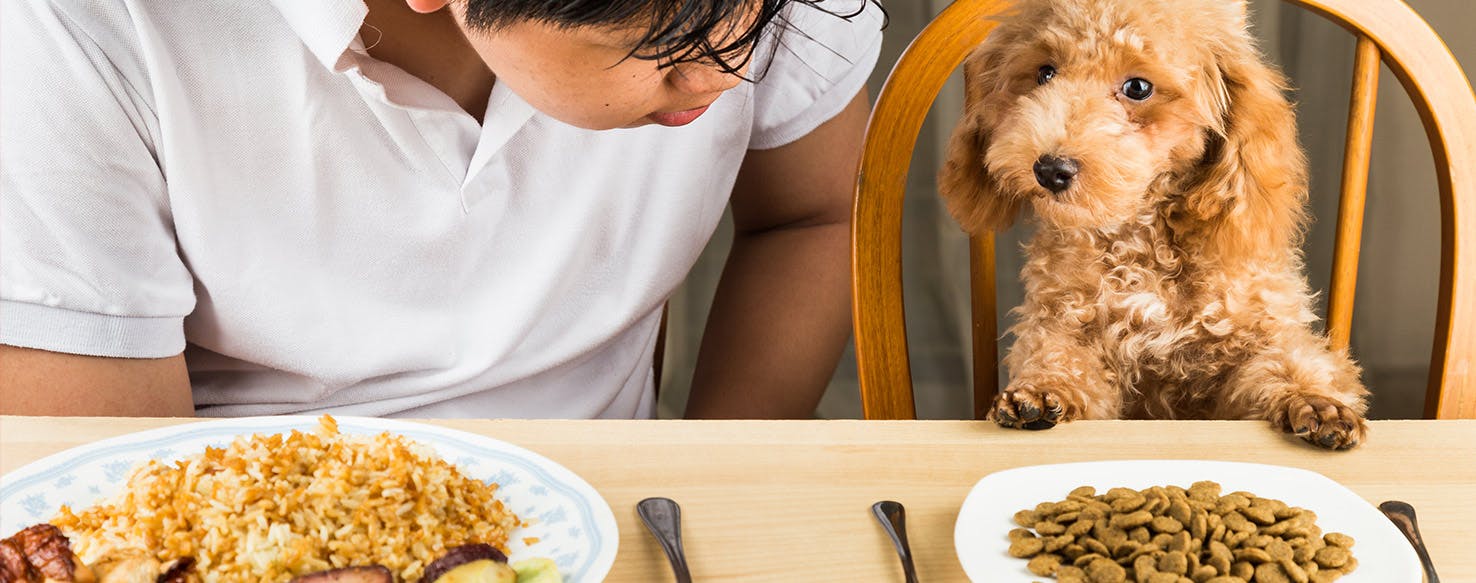- Home
- The Daily Wag!
- Senses
- Can Dogs Taste Human Food?

The dog can be such a little beggar in the kitchen. Every time we get something out to eat, they seem to know right away and come to check it out. It's tempting to share what we enjoy with them - to share the pleasure. After all, eating is a social experience, and our dogs are our best friends.
They beg so sweetly, but we can't help but believe that they find our food as scrumptious as we do. Before you go down the road of overindulgence with the human food, there are some things to consider about your dog's taste and nutritional needs.
Dogs will beg all the time. It seems as if they want any food, especially if it's something you are eating. Your dog will show you their appetite for your food as well as theirs in some ways. It is your job to make sure your dog is getting a healthy and balanced diet. It's easy to give treats to your pooch and to forget how many calories the dog is getting. It is also tempting to share food just for the fun of the positive attention your furry friend will show you. Whether begging or truly hungry, here are some signs your dog wants to eat!
Your dog will let you know when they want to eat. You will see the dog staring and staring. With focused attention and an alert stance, you will notice that your dog is ready to pounce and enjoy. The dog may give some signals of desire by movements of the eyebrows and ears. Dogs will lift the left eyebrow and move the left ear back when they see an object of affection - whether food or you. Drooling is a natural reaction to seeing something savory. There may even be some lip-licking as your dog anticipates food.
Guess what? Wanting to eat does not always mean that you are hungry. The same applies to your dog. Dogs will eat for a variety of reasons, mostly because the food is there and they can eat it. Dogs learn routines and they will look for things to happen at anticipated times.
For example, your dog may wake you up at the same time every day to go outside then have some breakfast. Your dog will be looking for you to come home at a regular time and feed him or her some dinner. And when it comes to eating your food? Well, if it is offered or readily available, they are going to give it a taste, just because they are dogs and they can.
Body Language
Signs your dog is into your food include:
- Staring
- Alert
- Lip Licking
- Drooling
- Ears Back
Other Signs
More signs that your dog likes human food are:
- Waiting In The Kitchen
- Following You Around Whenever You Have Food
- Eating Any Human Food Up When It Is Offered
The dietary needs of the dog reach back to their wolf ancestors. In the wild, dogs will eat meat and they will forage for berries. Dogs need a balanced diet from six classes of nutrients: protein, fat, carbohydrates, vitamins, minerals, and water. Seventy percent of your dog's body is made up of water.
Historians currently believe that the main reason that dogs came to befriend people has to do with wanting our food. Dogs have had a long love affair with human food, and will do just about anything to get our scraps.
In fact, "dog food" is a relatively new concept, as before, dogs were just given whatever food was left over from humans.
As much as we might want to believe that dogs can savor our food, they don't have our abilities to appreciate the flavors in food. Humans have about 9000 taste buds compared to just 1700 in the dog. We also rely on smell to enhance our taste experience.
When it comes to the dog's ability to taste, they do share in the ability to sense sweet, sour, bitter and salty. Because their diets are so heavily meat-reliant, they are sensitive to salt. It's not a good idea to share salty food with your dog.
They have special water receptors on the tip of the tongue, in the area where they lap liquids. When it comes to preferred flavors, dogs like meaty and sweet. Can your dog taste your food? If it's smelly, meaty, and sweet, they will get some enjoyment, but not as much as you. Bone Appetit!
There are things you can do to keep your dog from begging and harassing you when it's time for you to eat. First, do not feed your dog at the table. Bad habits begin when we allow the dog to do things we do not want them to do on a regular basis.
Second, only feed the dog in the dog's bowl. The only food the dog should receive from your hand is a treat that is a part of positive training exercises. Third, do not let the dog access your dining areas. Teach your dog to go lay down on their mat when you are eating.
Fourth, restrict access to food. Do not leave food or dirty dishes laying around the house. The best way to prevent bad habits it to not start them in the first place.
Have questions or concerns about your pet?
Chat with a veterinary professional in the Wag! app 24/7.
Get Vet ChatWritten by a Cavalier King Charles Spaniel lover Pat Drake
Veterinary reviewed by:
Published: 06/22/2018, edited: 04/06/2020
More articles by Pat Drake

